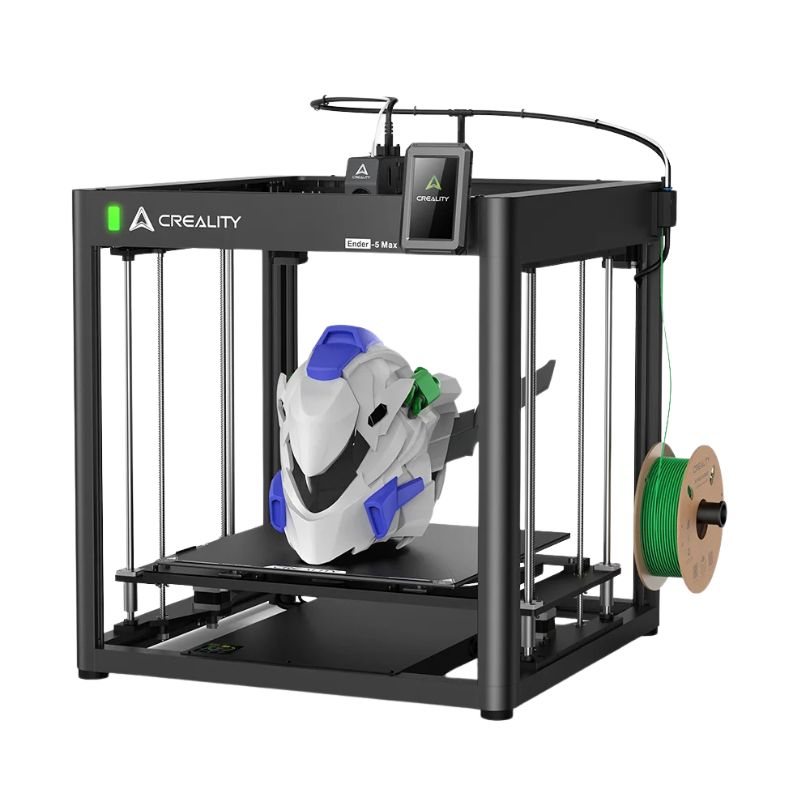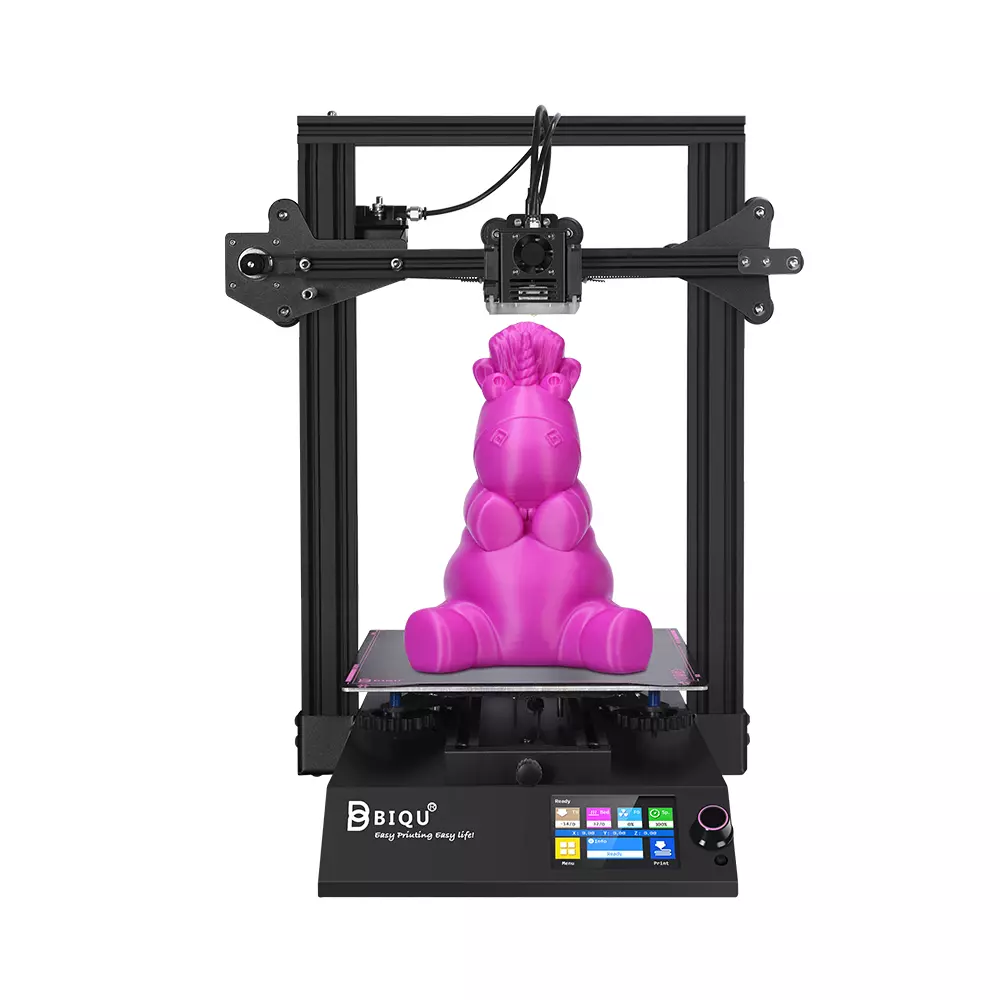Compare Ender 5 Max vs BIQU B1
Comparison between the best 3D printers
Choose the best 3D printer at the best price. The cheapest 3D printers are here.
Buy a 3D printer here with 3D Fila.
 |
 |
|
| Model | Ender 5 Max |
BIQU B1 |
| Printing Material | Filament | Filament |
| Buy Filament for Creality Ender 5 Max | Buy Filament forBigTreeTech BIQU B1 | |
| Estimated price | $769,00 | $269,00 |
| Manufacturer | Creality | BigTreeTech |
| Release Year | 2025 | 2020 |
| Print Volume [mm] | 400x400x400 | 235x235x270 |
| Printer Size [mm] | 649x721x850 | 412x402x492 |
| Weight [kg] | 25,9 | 8,00 |
| Power Loss Recovery | YES | YES |
| Enclosed printer | NO | NO |
| Bed Leveling | Automatic | Manual |
| Filament End Sensor | YES | YES |
| Bed type | Heated | Heated |
| Power supply system | Direct Drive | Bowden |
| Standard nozzle | 0,4 | 0,4 |
| Maximum Nozzle Temperature [°C] | 300 | 250 |
| Maximum Bed Temperature [°C] | 100 | 100 |
| Maximum printing speed [mm/s] | 700 | 100 |
| Filament holder | YES | YES |
| Camera for supervision | YES | YES |
| Recommended filaments | Hyper PLA/PLA/PETG/TPU95A/ABS/ASA/PLA-CF/PA/PLA-Silk | PLA, TPU, ABS, PETG |
| Recommended slicers | Creality Print 5.1 | Cura, Simplify, Slic3r |
| Maximum Resolution [mm] | 0,1 | 0,1 |
| Processor | 32 Bits BTT SKR V 1.4 | |
| Display | Touchscreen 4,3'' | Touchscreen TFT 3,5'' |
| Power Supply | 1250 W | 24V / 360W |
| Connectivity | USB, Wifi | SD / USB |
| Operating systems | Windows | Windows, Mac, Linux |
| Date of registration in the system | 2025-02-18 | 2021-04-14 |
| Release date | 2025 | 2020 |
| Extra features | The Ender 5 Max by Creality features a 400 x 400 x 400 mm build volume, a rigid aluminum frame, and 36-point auto bed leveling. With speeds up to 700 mm/s, it boasts a hardened dual-gear extruder and a 1000W heated bed, reaching 80°C in just 200 seconds. It supports remote management via WLAN, a tri-color status indicator, and quiet operation, making it ideal for high-precision, high-productivity 3D printing. | The BIQU B1 is an advanced 3D printer with a silent 32-bit BTT SKR V1.4 motherboard and ARM Cortex-M3 CPU, offering DIY interfaces (I2C, SPI, WiFi) and dual Z-axis. Its dual BTT B1 TFT35 V3.0 operating system allows real-time monitoring and multiple printing modes, including G-code visualization effects. It stands out for its BIQU SSS (Super Spring Steel), ensuring easy model adhesion and simplified removal, with the possibility of using it on both sides. It includes a filament sensor, automatically pausing printing in case of filament breakage. The multicolored RGB lights integrated into the hotend allow you to view the printing status even at night. Additional notes include the need for a BIQU-specific Type-C cable and extra interfaces for smart filament sensor and BL Touch. |
| Support for multiple colors and materials (AMS and CFS) | NO | NO |
Notes * |
||
| Cost-benefit | 7 / 10 | 7 / 10 |
| Hardware | 5 / 10 | 2 / 10 |
| Tela | . | . |
| Print volume | 4 / 10 | 3 / 10 |
| Performance | 6 / 10 | 1 / 10 |
Conclusion |
| In comparing the Ender 5 Max and the BIQU B1, several key differences and considerations arise that can guide potential buyers. The Ender 5 Max, with its larger print volume and significantly higher maximum printing speed, is well-suited for users seeking to produce larger and more intricate designs in a shorter timeframe. Its robust build quality and features such as automatic bed leveling and advanced connectivity options (including Wi-Fi) further enhance its appeal for serious hobbyists and professionals. Additionally, its ability to reach higher nozzle temperatures allows for a wider variety of filament types, making it a versatile choice for complex printing needs. On the other hand, the BIQU B1 presents itself as a more budget-friendly option while still offering solid performance for everyday 3D printing tasks. Although it has a smaller print volume and slower maximum speed, it includes useful features such as a filament end sensor and real-time monitoring capabilities, which can be advantageous for casual users or those venturing into 3D printing. Its ease of use and lower price point make it an attractive option for beginners or those with modest printing requirements. Ultimately, the choice between these two printers will depend on individual needs and budget. The Ender 5 Max is ideal for users who require higher performance and a larger build capacity, making it suitable for professional or advanced applications. In contrast, the BIQU B1 serves as a reliable entry-level option, providing good value for those looking to explore 3D printing without breaking the bank. Each printer has its strengths, and potential buyers should consider their specific use cases and preferences when making a decision. |

